The September 2016 unemployment report shows some fairly wild statistical swings that result in a distorted unemployment picture. The unemployment rate ticked up 0.1% to 5.0%. Over 350 thousand more were now considered employed. Both the labor participation rate and the civilian to employment ratio also ticked up a tenth of a percentage point. Last month there was almost no movement in the month to month unemployment statistics, taking into account margins of error, so this month seems to be the opposite.
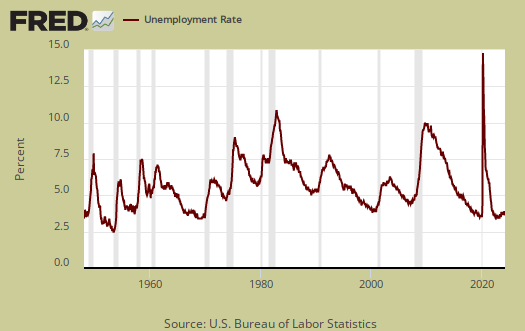
This article overviews and graphs the statistics from the Employment report Household Survey also known as CPS, or current population survey. The CPS survey tells us about people employed, not employed, looking for work and not counted at all. The household survey has large swings on a monthly basis as well as a large margin of sampling error. This part of the employment report is not about actual jobs gained but people and their labor status.
Those employed number 151,968,000, a monthly increase of 354 thousand. This is statistically unusual, a very large monthly swing. From a year ago, the ranks of the employed has increased by 3.026 million. That's a very solid annual gain.
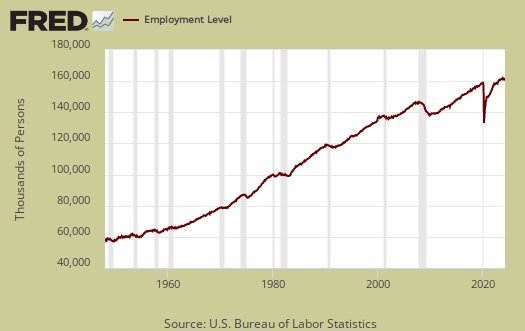
Those unemployed increased by 90 thousand for the month, a low figure. From a year ago the unemployed has decreased by only -14,000, another anomaly.

Those not in the labor force is 94.184 million, a -207 thousand monthly decrease. The below graph are the not in the labor force ranks. Those not in the labor force has decreased by -274,000 in the past year. This is probably a better job market and people finally getting jobs after years of not being counted as unemployed.
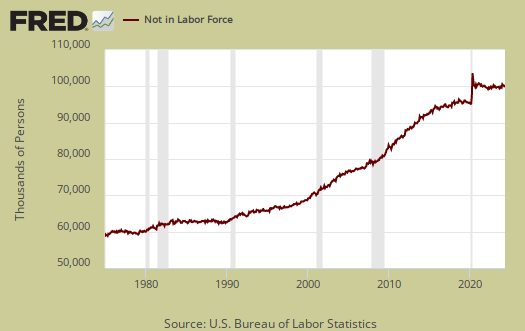
The labor participation rate is 62.9%, a 0.1 percentage point increase Pre-recession, the January 2008 labor participate rate was 66.2% a far cry from what we see today.

Below is a graph of the labor participation rate for those between the ages of 25 to 54. The rate is 81.5% and this is a 0.2 percentage point increase from last month, a very good sign. These are the prime working years where people are not in retirement or in school full time commonly, so one should not see record low participation rates In January 2008 the prime working years labor participate rate was 83.3%.

The civilian labor force, which consists of the employed and the officially unemployed, increased by 444,000 to 159,907,000. That is a very large amount for one month. The civilian labor force has grown by 3,040,000 over the past year. This is actually very high annual growth, we hope it is not artificial growth since the BLS counts those on guest worker Visas and even illegal workers mixed in with permanent resident and citizen workers.
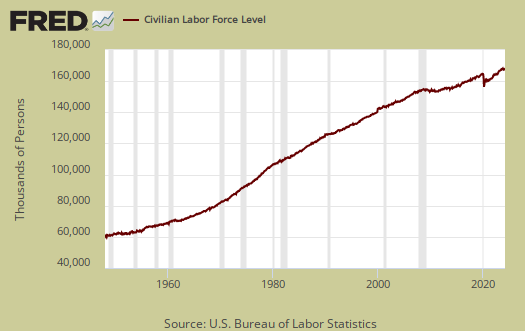
Below is a graph of those not in the labor force, (maroon, scale on the left), against the noninstitutional civilian population (blue, scale on the right). Notice how those not in the labor force crisscrosses the noninstitutional civilian population in growth. The civilian noninstituitonal population is from where all other labor statistics have sprung.

Below is a graph of the civilian labor force, or the official employed plus unemployed, in maroon, scale on left, against those not in the labor force, in blue, scale on right. See how those not in the labor force as a trend exceeded those considered employed and unemployed starting around mid 2009. Starting in 2014 it has reverted back, yet it oscillates starting in 2015. To have a solid employment situation those not in the labor force should be growing less than those obtaining jobs and being counted as looking for work. Those not in the labor force does include retirees and students and there is a baby bump with both of these segments of the population.
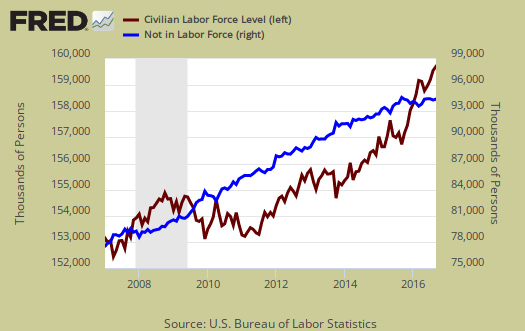
Those considered employed as a ratio to the total Civilian noninstitutional population is 59.7%, a 0.1 percentage point increase. In January 2008, this figure was 62.9%. The relationship between the employment-population ratio and the labor participation rate (LPR) is: employment-population ratio = LPR * (1 - unemployment rate).
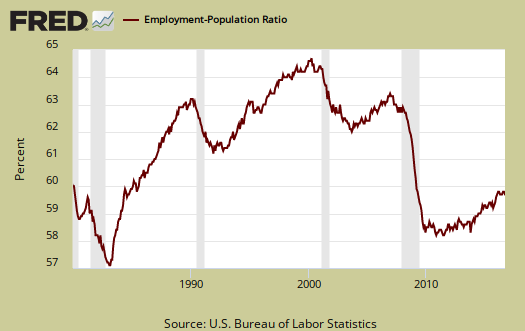
U-6 still stands at 9.7%, which is no change from last month. U-6 is a broader measure of unemployment and includes the official unemployed, people working part-time hours because that's all they can get and a subgroup not counted in the labor force but are available for work and looked in the last 12 months. The U-6 rate still leaves out some people wanting a job who are not considered part of the labor force, so while it is called an alternative rate, but it still ignores many who should be counted as unemployed.
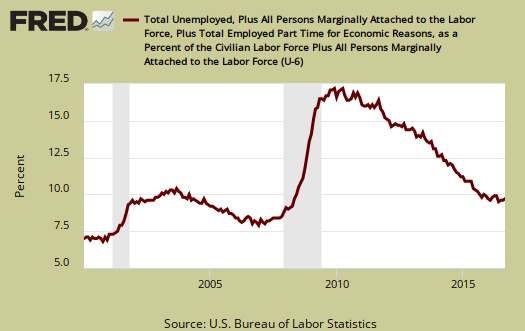
This month's CPS report by itself was amazingly static with some wild swings from last month. That said, the CPS is notoriously volatile with 100,000 data size swings routine from month to month. Here are our past overviews CPS unemployment statistics, only graphs revised.

Recent comments